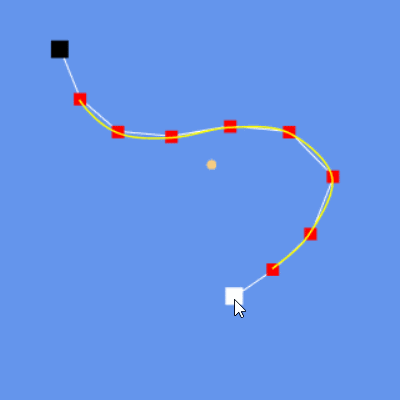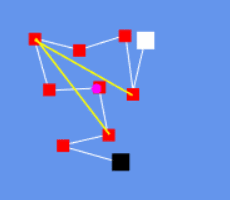It’s there:
https://github.com/sqrMin1/MonoGame.SplineFlower/tree/master/Utils
It’s there:
https://github.com/sqrMin1/MonoGame.SplineFlower/tree/master/Utils
Great, thank you a lot:
But how do I reference it?
I would presume that it was included in the Monogame.SplineFlower.dll…
That, I don’t know, I am not that far with tinkering right now…
I will take a look at this soon. Currently pretty busy.
The problem should be fixed now. Please install the newest nuget package(s).
https://www.nuget.org/packages/MonoGame.SplineFlower/
https://www.nuget.org/packages/MonoGame.SplineFlower.Content/
https://www.nuget.org/packages/MonoGame.SplineFlower.Content.Pipeline/
Breaking Changes: this update is not compatible with older versions of this library!
–
Heyya, here is finally the update I wanted to do for a longer time now: it’s nothing less than a complete overhaul of the library.
It should be easier now to understand and use it. Unfortunatley this makes it incompatible with older versions. Espacially your generated splines will not likely to load.
However, adding new spline types is now a breeze. That’s why a new spline type is already included with this update; the Hermite Spline!
Let’s take a look:
The Hermite Spline is basically a CatMulRom Spline, but you have more control over it by setting “bias” and “tension” values. On top of it there a moveable tangents (the orange handles in the animation), which makes it possible to control the curve more precisely.
And this is what gives you design and typography powers now. Look at this:
Things like that are created in minutes. Try it for yourself with the included samples and editor project!
I also reworked the PolygonSpline sample a bit, by adding a new road texture and some checkboxes to enable or disable specific visual elements of the spline:
BTW: the MonoGame ContentManager is fully supported!
Load a spline simply like this:
MySpline = Content.Load<SplineBase>(@"HermiteTest");
Nugets are fully generated and uploaded for the ease of integration!
Phew… now I have this library in a state I always wanted it to be. It is ready for further production in other projects. This is incredible if you think about the fact that this library exists since Aug 14, 2018.
But it is definitley worth the time.
My intention is to implement the MonoGame.SplineFlower library into the Mercury Particle Sandbox:
… and let thousands of particles flow on the splines.
Feel free to click on the link above to find out more about my particle sandbox!
And feel free to follow the further development process of my projects here in MonoGame or via steam dev, steam news, twitter, indiedb or even youtube.
Thank you very much for your support and have a nice day! ![]()
:: Marcel ![]()
Updated the repo according to the new law in germany, which sais that the symbolic usage of the letter “Z” is forbidden now, because of the war in ukraine, triggered by Wladimir Putin.
Here is the repo link:
Here is a before/after comparison for your imagination:
Here is the mini-changelog:
Notes:
The core functionallity of the library is still the same, which means that for example the default generation of a spline with the command MySpline.Reset() still generates a white baseline which looks like a “Z”. This is to visualize the specific technical curve of the corresponding spline and has nothing to do with a symbolic usage.
This repo/library exists since 14.08.2018 - long time before anyone could ever think about that a simple letter like “Z” could be a symbol of war like the “swatiska”.
Explanation:
I’m doing these changes mainly on the public frontsite of my github repo page to avoid conflicts with the law. I am not doing this because I’m paranoid, I’m doing this because alot of other people are paranoid these days. And yeah… It’s valid law now in germany and you can get in jail for 3 years or getting financial penalties when using the letter “Z” now…
I wish I could say this is a joke, but it isn’t.
Other than that I wish you a peacful day. And let’s hope together that this nightmare will end soon and that we all can live in peace and harmony again.
Cheers!
:: Marcel 


PS: I’m also planning a new update with new functionalities for this library - soon more.
PPS: I hope I made clear that I am against war of any kind. I am not supporting Putin or the war - of course not!

EndPointColor and EndPointThickness to the Setup class.StartPointColor from Magenta to White.EndPointColor is Black, so the user can easily determine if such a specific point is the start or the end of a spline.DrawPoint()and DrawLine() methods.Spline.Draw() now instead of Spline.DrawSpline().i3-9100F CPU @ 3.60GHz | GTX 1050 Ti
When the selected Point (center) of a Spline is moving, then his direct neighbours (left & right) will check their distances to him.
Point.Point.Now that the neighbours are moving, the neighbours of those neighbours are checking for distances. This is a recursive operation as you can see and it’s happening for the whole spline every frame in the game loop (update). On top of it there is a distance and angle calculation in the draw method of a spline - also happening each frame, which draws the actual spline; the curve (yellow), the direction vectors (green), the tangents (orange) the base line (white) and the points (usually red) - at least if you want to show them all.
The most demanding operation is of course to draw the curve, because each segment (4 connected points) has roughly 300 yellow dots. In the last performance test of the video you see 100921 sprites (curve + points + base line + center point). The generated spline contains 304 points, so 300 dots * 304 points = 91200 sprites at the default spline resolution of 1000 - just for the yellow curve.
Angle and distance calculations are happening on every single dot right now, so my plan in a future update of the library is to only calculating those values on demand and maybe storing them in an array. I can also imagine to have custom fixed recalculation intervals on the spline, so that for example such calculations only happening 1, 10, 33 times per frame (and/or on demand) - adjustable by the user; either per spline or per project (setup class). Another thing is to use a sprite sheet for the textures. It’s just a square and a circle but reducing texture swaps should always be the aim. On top of it this is an easy addition, so it’s a must have.
The question you are probably asking right now is: “why do you even care about such big splines? o.O”
This leads me to the next topic…
I want to extend this library with bigger (and more impressive) features. One of them is the ability of creating branches!
It should be possible to select a point on the curve and then just create a branch on that point. From this branch-connection it should be possible to connect other splines. And on such connected splines it should be possible to … right, create even more branches! ![]()
This can lead to HUGE spline-networks. And now imagine you would move points on that network in a recursive way using this “Chain-Spline-Technology”… YES, now we are talking. ![]()
You see? Performance is an important factor and big splines are a very great way of testing different performance scenarios - on the way to the branch-feature in one of the next updates.
Keep curious and stay tuned! ![]()
Have a nice day! ![]()
:: Marcel
PS: Sorry for the wall of text ![]()
i3-9100F CPU @ 3.60GHz | GTX 1050 Ti
The old performance test from my last post showed that the maximum limit of sprites to draw a curve of a spline was about 100.000, which usually resulted in having roughly 300 control points (red squares) on the spline. This however, was because of the fact, that such a spline would have a resolution of 1000. This means maximum quality and ultra smooth curves - of the costs of performance of course… huge costs ![]()
I’m now using a formula which bounds the spline resolution to a value called “SplineStepDistance”.
I calculate it like this:
SplineStepDistance = SplineMarkerResolution / (float)Math.Pow(SplineMarkerResolution, 2) * 3f;
The draw function of the spline now uses this value to raise “t” along all control points, like this:
for (float t = 0; t < _Points.Length; t += Setup.SplineStepDistance)
So, the lower the SplineResolution, the higher the SplineStepDistance, the shorter the for loop, the faster the draw function… ![]() (much faster).
(much faster).
This interpolates the curve like this:

From low resolution to high resolution.
As a result the new limits are much more impressive. We are going from ~300 control points for ~100.000 sprites to ~9000[!] control points for ~50.000[!] sprites. This means we can have 30x more control points, but only using half of the sprites as before. Surprisingly the curve is still looking pretty much smooth.
But why?
Well, the answer is simply: because the distance between each control point is very short, which makes the curve generation naturally smoother. I am using this little trick to boost the performance immensely without taking away to much quality.
In fact this boosted the performance that much, that we would rather get a stack overflow exception from the recursive operations of the chain spline control points, than a FPS-drop…
On the other hand it would be interesting to experiment with shaders to push some work to the GPU. Espacially when it comes to calculate angle and distances. But at this point this would only raise the quality of a spline, because we could set a higher spline resolution then. The FPS are already stable.
And this is the reason for me to go further in developing new features for MonoGame.SplineFlower like the complex “branching system”.
I hope you enjoyed the performance video and this update in general.
Keep curious and stay tuned! ![]()
Have a nice day ![]()